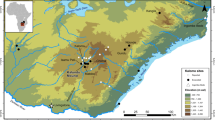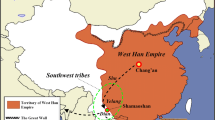Abstract
The dominant model of relations between Zhizo- and Leopard's Kopje-ceramic using groups in northern South Africa, southwestern Zimbabwe, and eastern Botswana between AD 1000 and 1300 has been one of hostile invasion by Leopard's Kopje groups, who are thought to have forced Zhizo groups into eastern Botswana (Huffman, 1978, 1986a, 1996). Leopard's Kopje groups are thereupon thought to have set about the process of nascent state formation in the absence of any significant contact, other than violence or intermittent intermarriage (Denbow, 1982, 1983, 1986; Huffman, 1986a, 1996), with their Zhizo (i.e., Toutswe) neighbors to the west. More recently, Denbow (1990) has modified his position to include trade in exotic goods as a regular feature of Leopard's Kopje–Zhizo relations. Radiocarbon and ceramic data from the Iron Age site Leokwe Hill, in combination with the available ceramic data and a reanalysis of the ceramics from the site Schroda, indicate that current interpretations of the relations between Zhizo and Leopard's Kopje groups need to be reconsidered. New hypotheses are presented that posit that the nature and intensity of interaction between these groups was more far-reaching than is currently thought.
Le modéle dominant des relations entre les groupes qui ont utilisés les ceramiques Zhizo et ceux qui ont utilisés celles de Leopard's Kopje dans le nord de l'Afrique du Sud, sud-est du Zimbabwe et l'est du Botswana entre AD 1000 et 1300, a été l'invasion hostile par les groupes de Leopard's Kopje, qui, l'on pense avoir forcé les groupes Zhizo dans l'est du Botswana (Huffman, 1978, 1986a, 1996). Les groupes de Leopard's Kopje sont pensés avoir établi le procédée de l'état de formation (nascent) en l'absence de tous contacts significatifis, autre que la violence ou des mariages consanguins intermittents (Denbow, 1982, 1983, 1986; Huffman, 1986a, 1996), avec leur Zhizo (c.à.d. Toutwse) voisins à l'ouest. Récemment, Denbow (1990) a modifié sa position pour inclure le commerce des produits exotics comme une caractéristique réguliere des relations entre Leopard's Kopje et Zhizo. Le radiocarbonne et les données en céramique du site de l'âge de fer Leokwe Hill, en combinaison avec les données de céramiques disponibles et une ré-analyse des céramiques du site Schroda, indiquent que les interprétations des relations entre Zhizo et les groupes de Leopard's Kopje doivent être reconsidêrées. Des nouvelles hypothéses sont présentées qui proposent que la nature et l'intensité des interactions entre ses groupes étaient d'ptune portée bien plus grande que nous le pensons actuellement.
Similar content being viewed by others
REFERENCES
Brain, C. (1947). Human food remains from the Iron Age at Zimbabwe. South African Journal of Science 70: 303–309.
Calabrese, J. (in preparation). The Rise of Social and Political Complexity in the Area of the Shashi-Limpopo Confluence, Ph.D. Thesis, University of the Witwatersrand, Johannesburg.
Denbow, J. (1982). The Toutswe Tradition: A study in socioeconomic change. In Hitchcock, R., and Smith, M. (eds.), Settlement in Botswana, Heinemann, Johannesburg, pp. 73–86.
Denbow, J. (1983). Iron Age Economics: Herding,Wealth, andPolitics Along theFringes of the Kalahari Desert During the Early Iron Age, Ph.D. Thesis, Indiana University, Bloomington.
Denbow, J. (1984). Cows and Kings: A spatial and economic analysis of a hierarchical Early Iron Age settlement system in eastern Botswana. In Hall, M., Avery, G., Avery, D. M., Wilson, M. L., and Humphreys, A. J. B. (eds.), Frontiers: Southern African Archaeology Today, British Archaeological Reports International Series 207, Oxford, pp. 24–39.
Denbow, J. (1986). A new look at the later prehistory of the Kalahari. Journal of African History 27: 3–28.
Denbow, J. (1990). Congo to Kalahari: Data and hypotheses about the political economy of the western stream of the Early Iron Age. African Archaeological Review 8: 139–176.
De Vaal, J. (1943). 'n Soutpansbergse Zimbabwe. South African Journal of Science 40: 303–327.
De Wet, E. (1993). Methodological Considerations of Late Iron Age Fauna From the Soutpansberg, M.A. Thesis, University of the Witwatersrand, Johannesburg.
Eloff, J., and Meyer, A. (1981). The Greefswald sites. In Voigt, E. (ed.), Guide to Archaeological Sites in the Northern and Eastern Transvaal, Southern African Association of Archaeologists, Pretoria, pp. 7–22.
Fouch´e, L. (1937). Mapungubwe: Ancient Bantu Civilization on the Limpopo, Cambridge University Press, Cambridge.
Friedman, J., and Rowlands, M. (1977). Notes towards an epigenetic model of the evolution of 'civilization.' In Friedman, J., and Rowlands, M. (eds.), The Evolution of Social Systems, Duckworth, London, pp. 201–276.
Gardner, G. (1963). Mapungubwe, Vol. II, J. L. van Schaik, Ltd., Pretoria.
Garlake, P. (1973). Great Zimbabwe, Thames and Hudson, London.
Hanisch, E. (1980). An Archaeological Interpretation of Certain Iron Age Sites in the Limpopo/Shashi Valley, M. A. Thesis, University of Pretoria, Pretoria.
Hanisch, E. (1981). Schroda: A Zhizo site in the Northern Transvaal. In Voigt, E. (ed.), Guide to Archaeological Sites in the Northern and Eastern Transvaal, Southern African Association of Archaecologists, Pretoria, pp. 37–53.
Hanisch, E. (n.d.). Excavations at Commando Kop [Glennel], Manuscript on file at the Department of Archaeology, University of the Witwatersrand, Johannesburg.
Huffman, T. (1974). The Leopard's Kopje Tradition, Museum Memoir No. 6, National Monuments and Museums of Rhodesia, Salisbury.
Huffman, T. (1978). The origins of Leopard's Kopje: An 11th century difaqane. Arnoldia 7:1–12.
Huffman, T. (1982). Archaeology and ethnohistory of the African Iron Age. Annual Review of Anthropology 11: 133–150.
Huffman, T. (1984). Leopard's Kopje and the nature of the Iron Age in Bantu Africa. Zimbabwea 1: 28–35.
Huffman, T. (1986a). Iron Age settlement patterns and the origins of class distinction in southern Africa. In Wendorf, F., and Close, E. (eds.), Advances in World Archaeology5, Academic Press, New York, pp. 291–338.
Huffman, T. (1986b). Archaeological evidence and conventional explanations of southern Bantu settlement patterns. Africa 56: 280–298.
Huffman, T. (1989). Ceramics, settlements, and late Iron Age migrations. African Archaeological Review 7: 155–182.
Huffman, T. (1996). Snakes and Crocodiles, Witwatersrand University Press, Johannesburg.
Kiyaga-Mulindwa, D. (1990). Excavation at Lose Enclosure, Central Botswana. In Sinclair, P., and Pwiti, G. (eds.), Urban Origins in Eastern Africa: Proceedings of the 1990Workshop, The Central Board of National Antiquities, Stockholm, pp. 48–59.
Mauss, M. (1990). The Gift, W. W. Norton, New York and London.
Meyer, A. (1980). n'Interpretasie van die Greefswald Potwerk, M.A. Thesis, University of Pretoria, Pretoria.
Polanyi, K. (1957). The economy as instituted process. In Polanyi, K., Arensberg, C., and Pearson, H. (eds.), Trade and Market in Early Empires: Economies in History and Theory, The Free Press and The Falcon's Wing Press, Glencoe, pp. 243–269.
Prinsloo, H. (1974). Early Iron Age sites at Klein Afrika. South African Journal of Science 70: 271–273.
Renfrew, C. (1986). Introduction. In Renfrew, C., and Cherry, J. (eds.), Peer-Polity Interaction and Sociopolitical Change, Cambridge University Press, Cambridge, pp. 1–18.
Robinson, K. (1966). The Leopard's Kopje culture: Its place in the Iron Age of southern Rhodesia. South African Archaeological Bulletin 21: 5–51.
Robinson, K. (1985). Dated Iron Age sites from the upper Umguza Valley 1982: Their possible implications. South African Archaeological Bulletin 40: 17–38.
Schofield, J. (1937). Work Done in 1934: Pottery. In Fouch´e, L. (ed.), Mapungubwe: Ancient Bantu civilization on the Limpopo, Cambridge University Press, Cambridge, pp. 32–61.
Schortman, E. (1989). Interregional interaction in prehistory: The need for a newperspective. American Antiquity 54: 52–65.
Steyn, M. (1994). An Assessment of the Health Status and Physical Characteristics of the Prehistoric Populations from Mapungubwe, Ph.D. Thesis, University of the Witwatersrand, Johannesburg.
Thorp, C. (1984). Faunal Remains as Evidence of Social Stratification at Great Zimbabwe, M.A. Thesis, University of the Witwatersrand, Johannesburg.
Thorp, C. (1995). Kings, Commoners and Cattle at Zimbabwe Tradition Sites, Museum Memoir Series No. 1, National Museums and Monuments of Zimbabwe, Harare.
Vogel, J. (in preparation). Radiocarbon dating of the Iron Age sites on Greefswald Farm.
Voigt, E. (1983). Mapungubwe: An Archaeozoological Interpretation of an Iron Age Community, Museum Monograph No. 1, Transvaal Museum, Pretoria.
Willey, G., and Phillips, P. (1958). Method and Theory in American Archaeology, University of Chicago Press, Chicago and London
Author information
Authors and Affiliations
Additional information
Sashi-Limpopo Archaeological Project
Rights and permissions
About this article
Cite this article
Calabrese, J.A. Interregional Interaction in Southern Africa: Zhizo and Leopard's Kopje Relations in Northern South Africa, Southwestern Zimbabwe, and Eastern Botswana, AD 1000 to 1200. African Archaeological Review 17, 183–210 (2000). https://doi.org/10.1023/A:1006796925891
Issue Date:
DOI: https://doi.org/10.1023/A:1006796925891




